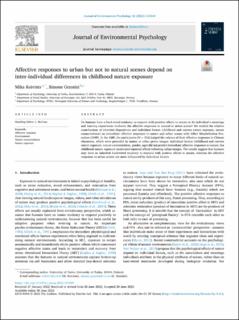| dc.contributor.author | Koivisto, Mika | |
| dc.contributor.author | Grassini, Simone | |
| dc.date.accessioned | 2022-09-30T08:27:53Z | |
| dc.date.available | 2022-09-30T08:27:53Z | |
| dc.date.created | 2022-09-26T12:49:26Z | |
| dc.date.issued | 2022 | |
| dc.identifier.citation | Journal of Environmental Psychology. 2022, 82 1-10. | en_US |
| dc.identifier.issn | 0272-4944 | |
| dc.identifier.uri | https://hdl.handle.net/11250/3022751 | |
| dc.description.abstract | Do humans have a hard-wired tendency to respond with positive affects to nature or do individual's meanings and learning experiences moderate the affective responses to natural or urban scenes? We studied the relative contributions of inherited dispositions and individual factors (childhood and current nature exposure, nature connectedness) on immediate affective responses to nature and urban scenes with Affect Misattribution Procedure (AMP). In the AMP, the participants (N = 316) judged the valence of their affective responses to Chinese characters, which were preceded by nature or urban prime images. Individual factors (childhood and current nature exposure, nature connectedness, gender, age) did not predict immediate affective responses to nature, but childhood nature exposure moderated reported affects following urban images. The results suggest that humans may have an inherited hard-wired tendency to respond with positive affects to nature, whereas the affective responses to urban scenes are more influenced by individual factors. | en_US |
| dc.language.iso | eng | en_US |
| dc.publisher | Elsevier | en_US |
| dc.rights | Navngivelse 4.0 Internasjonal | * |
| dc.rights.uri | http://creativecommons.org/licenses/by/4.0/deed.no | * |
| dc.title | Affective responses to urban but not to natural scenes depend on inter-individual differences in childhood nature exposure | en_US |
| dc.title.alternative | Affective responses to urban but not to natural scenes depend on inter-individual differences in childhood nature exposure | en_US |
| dc.type | Peer reviewed | en_US |
| dc.type | Journal article | en_US |
| dc.description.version | publishedVersion | en_US |
| dc.source.pagenumber | 1-10 | en_US |
| dc.source.volume | 82 | en_US |
| dc.source.journal | Journal of Environmental Psychology | en_US |
| dc.identifier.doi | 10.1016/j.jenvp.2022.101840 | |
| dc.identifier.cristin | 2055438 | |
| cristin.ispublished | true | |
| cristin.fulltext | original | |
| cristin.qualitycode | 2 | |

